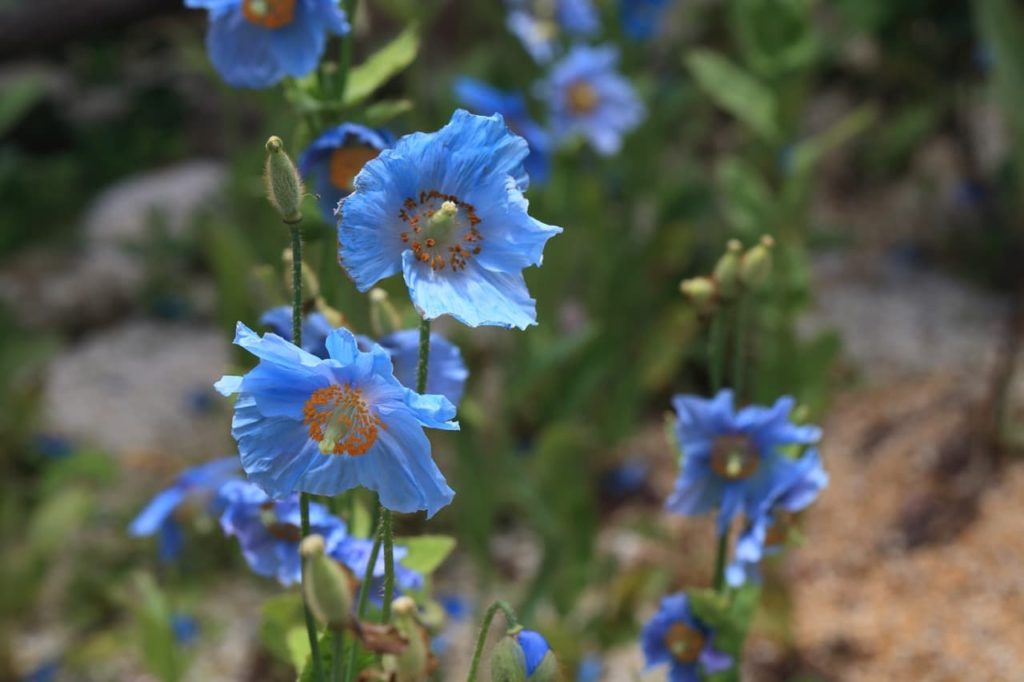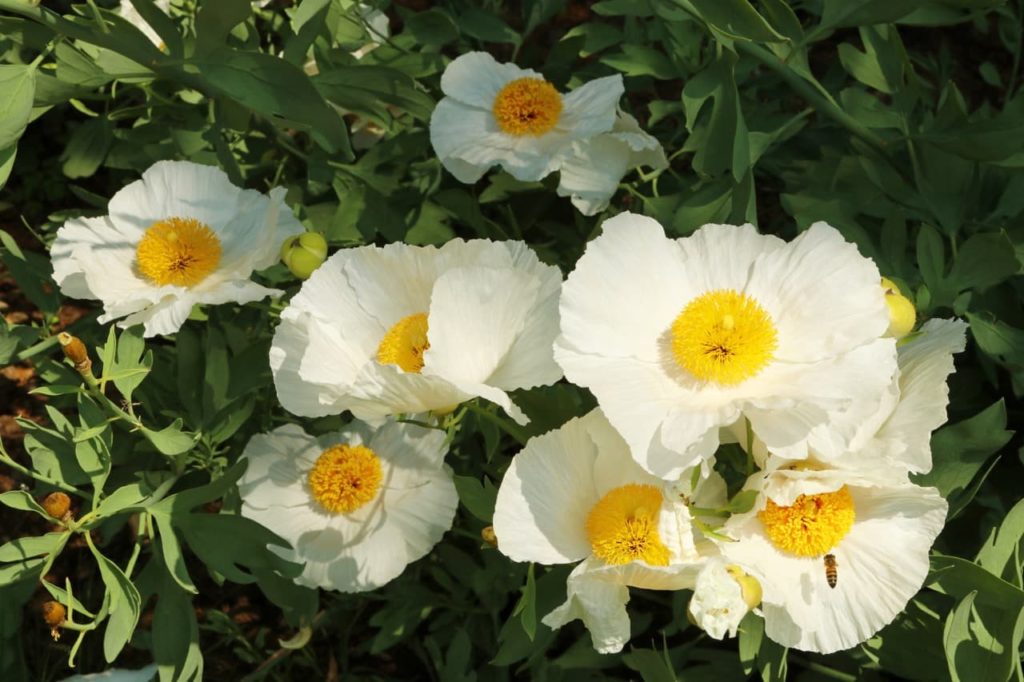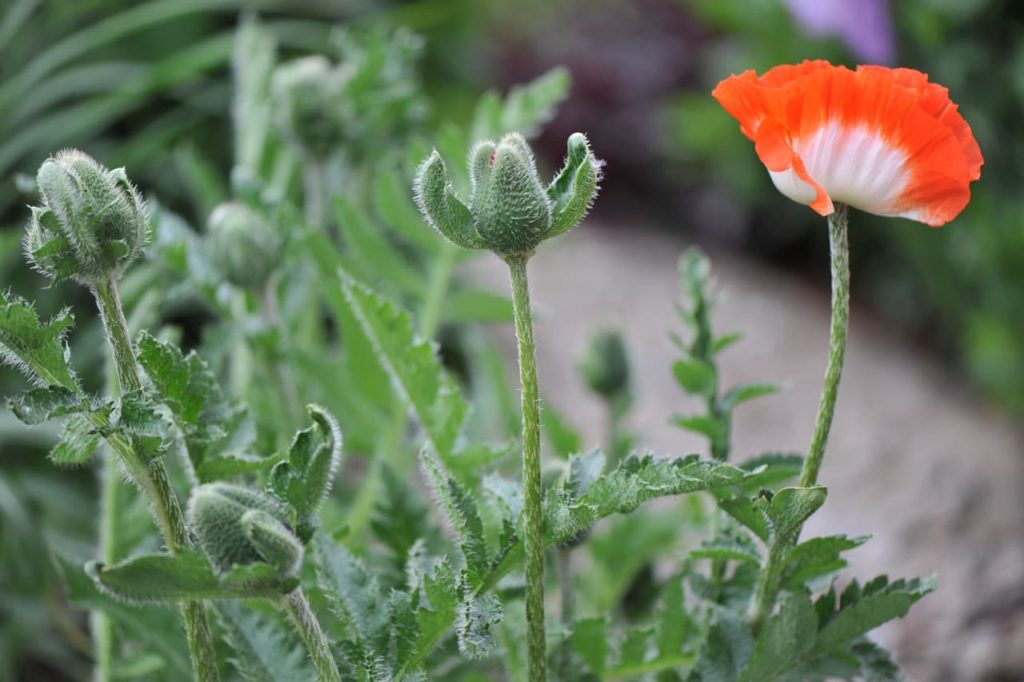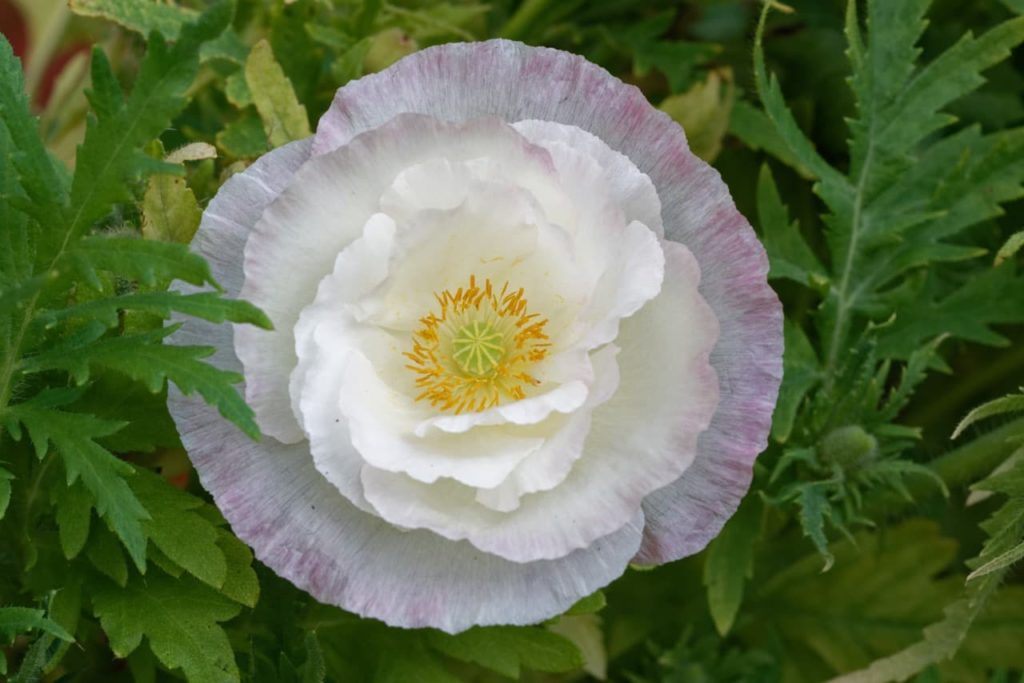Reviewed By COLIN SKELLY

Colin is a Horticulturist and Horticultural Consultant with experience in a range of practical and managerial roles across heritage, commercial and public horticulture. He holds the Royal Horticultural Society’s Master of Horticulture award and has a particular interest in horticultural ecology and naturalistic planting for habitat and climate resilience.
Contributions From THE 3 GROWBAGS

What started as a blog turned into a huge project and an online shop for sisters Elaine, Caroline and Laura, who make up The 3 Growbags. They frequently document their journey and have made appearances at several RHS shows. All three are full members of the Garden Media Guild.
IN THIS GUIDE
- 1) P. rhoeas
- 2) P. somniferum
- 3) P. nudicaule
- 4) P. alpinum
- 5) Meconopsis betonicifolia
- 6) M. ‘Strathspey’
- 7) M. grandis ‘Betty Sherriff’s Dream Poppy’
- 8) Romneya coulteri
- 9) P. commutatum
- 10) P. somniferum ‘Black Paeony’
- 11) P. rhoeas ‘Picotee Mixed’
- 12) P. orientale ‘Beauty of Livermere’
- 13) P. orientale ‘Black and White’
- 14) P. orientale ‘Flamingo’
- 15) P. orientale ‘Pinnacle’
- 16) P. orientale ‘Carmen’
- 17) P. rhoeas ‘Supreme’
- References
POPPY GUIDES
Growing From Seed
Varieties
Poppy species and their derivatives combine for a total numbering many hundreds.
The great majority of these varieties are annuals or biennials, whilst some are deciduous perennials.
However, what exactly is a poppy?
Many plants that we call poppies fall within the genus Papaver, but there’s a twist here.
The common name ‘poppy’ has a one-to-one correspondence with the botanical family Papaveraceae, meaning that many genera and all their respective varieties are encompassed within the common name.
This is the reason that you will find plants of different genera in our list underneath.
However, the large majority of garden poppies are cultivars of Papaver orientale and, therefore, its cultivars make up the majority of our cultivar selections.
1) P. rhoeas

- COMMON NAME(S): common / field / flanders poppy
- HARDINESS RATING: H7
- FLOWERS: red
The bowl-shaped flowers, tissue-thin translucent petals, and the glowing vermilion hue are the familiar elements from which the common poppy is composed.
The leaves are very pretty too, being pinnate and of a cool green shade.
This annual is 70-80cm tall.
The flowering season is variable, but it typically occurs in June and sometimes runs into July.
Those lapel pins and small artificial flowers you can see around Remembrance Day in the UK are modelled on this poppy species, which still blankets some World War I battlegrounds and burial grounds during the summer.1Imperial War Museums. (n.d.). Why We Wear Poppies On Remembrance Day. Retrieved March 23, 2023, from https://www.iwm.org.uk/history/why-we-wear-poppies-on-remembrance-day
2) P. somniferum

- COMMON NAME(S): opium poppy
- HARDINESS RATING: H5
- FLOWERS: purple, pink, red and white
Listed objectively because of its unquestionable beauty, the opium poppy, for better or for worse, is very easy to grow and bears very decorative flowers.
In single or semi-double form, they are open and cup-shaped, with fringed and frilly petals.
In nature, this annual is found in tones of pink, magenta, purple and red.
Its flowers have a yellow boss and its petals have a dark blotch at the base.
The plant grows to 1-1.2m high.
3) P. nudicaule

- COMMON NAME(S): Icelandic poppy / arctic poppy
- HARDINESS RATING: H7
- FLOWERS: orange, red, yellow and white
The Poppy species that looks most like a wildflower is perhaps the Icelandic poppy.
The plants are relatively diminutive at 30-45cm and the bowl-shaped flowers are only about 5cm wide, occurring in light and bright tones of yellow, orange, white and scarlet, without any dark marks or blotches on the petals.
They have a prominent centre of bright yellow stamens.
This arctic native is in bloom throughout much of the summer.
Belying its wildflower looks, this delightful poppy is a perennial, albeit a short-lived one.
4) P. alpinum

- COMMON NAME(S): alpine poppy
- HARDINESS RATING: H6
- FLOWERS: orange, white, red and yellow
Giving stiff competition to any other poppy in the wildflower department, the alpine poppy grows to a height of only around 20cm.
Its blooms are quite like meadow wildflowers, as they are bowl-shaped and occur in shades of pure white and in gentle, bright tones of yellow, orange and scarlet.
Its unusual tufted habit, in addition to its other qualities, makes this short-lived perennial simply fantastic for rockeries.
It blooms for most of the summer.
5) Meconopsis betonicifolia

- COMMON NAME(S): Himalayan poppy / blue poppy
- HARDINESS RATING: H4
- FLOWERS: blue
Even though it is as hard to find as it is hard to grow, the Himalayan poppy still makes a name for itself because of the breathtaking blooms it produces.
“I could not live without my meconopsis (Himalayan blue poppy),” says Caroline from The 3 Growbags.
“It’s an absolute jaw-dropper and loves the Highland soil and climate. Laura bought me mine so they’ll always be special, however, neither of my sisters are able to grow this stunner where they live which, from a sibling rivalry point of view, is very satisfying.”
The salver-shaped flowers have a delicate appearance courtesy of their frilly, crinkled petals, which are a light and limpid blue-to-lilac hue.
These 8cm blooms are centred by a boss of yellow stamens.
Measuring over 1m tall, this species is tall for a poppy.
The large leaves are worth a mention, as they have a visible nap and are properly bluish-green.
6) M. ‘Strathspey’
- COMMON NAME(S): Himalayan poppy ‘strathspey’
- HARDINESS RATING: H5
- FLOWERS: blue and purple
A relatively recent cultivar of Meconopsis, ‘Strathspey’ produces one of the most intensely coloured poppies of all the varieties on this list.
These salver-shaped blooms are of a deep royal purple to a dramatic dark violet hue and present a satiny sheen.
They have wonderfully contrasting golden-yellow centres.
These perennials are 70-80cm tall.
The blooming season starts in late spring and continues into mid-summer.
7) M. grandis ‘Betty Sherriff’s Dream Poppy’

- COMMON NAME(S): Himalayan blue poppy ‘Bobby Masterton’
- HARDINESS RATING: H5
- FLOWERS: blue
This hard-to-grow poppy will have your guests enquiring about its mouthful of a name, for its flowers are an impossible sky-blue tone, sometimes with light purple flushes or streaks.
They are made all the more striking because of the gauzy petals that appear translucent because of their light limpid shade.
The flowers’ form is rather open and salver shaped and the central stamens are usually inconspicuous.
The foliage brings a dash of interest, as young leaves display a purplish blush.
This short-lived perennial can grow up to 1m in height.
It flowers in the early part of summer and is a recipient of the RHS Award of Garden Merit.
8) Romneya coulteri

- COMMON NAME(S): Californian tree poppy
- HARDINESS RATING: H5
- FLOWERS: white and yellow
Very much a real poppy considering that it belongs to the family Papaveraceae, the Californian tree poppy, not to be confused with Californian poppies, is very popular in the UK – and for good reason.
The crinkly-petalled, bowl-shaped flowers can reach up to 15cm across and are a snowy-white colour with a conspicuous bright golden centre.
This perennial rises to 1.5-2m.
The flowering season is very variable and greatly depends on region and climate, but it covers a good part of the summer.
This variety has been awarded the RHS Award of Garden Merit.
9) P. commutatum

- COMMON NAME(S): caucasian scarlet poppy
- HARDINESS RATING: H5
- FLOWERS: red and black
The caucasian scarlet poppy produces 7cm-wide flowers of a brilliant hue that ranges from scarlet to deep red.
Each petal has a big black blotch near its base.
One of the showier poppies, this species’ flowers are properly bowl-shaped.
Their blooming schedule covers the bridge season of late spring to early summer.
The longish leaves are both pretty and unusual for they are pinnatifid – partially pinnate-cut.
This annual reaches up to 40cm in height and is another recipient of the RHS Award of Garden Merit.
10) P. somniferum ‘Black Paeony’
- COMMON NAME(S): opium poppy ‘black paeony’
- HARDINESS RATING: H5
- FLOWERS: black
The most eye-catching and dramatic of all the poppies is, undoubtedly, the ‘Black Paeony.’
The fully double-form flowers, which resemble peonies, are composed of glossy, silky ruffled petals.
These flowers are huge at 10-12cm in diameter and they range in colour from deep purple with white streaks to virtually black.
Even the foliage is worth a mention, for the leaves are cordate, have wavy margins and are of a silvery sea-green tone.
This annual is about 90cm tall and blooms from mid-summer and may continue to flower until early autumn.
11) P. rhoeas ‘Picotee Mixed’
- COMMON NAME(S): poppy ‘picotee mixed’
- HARDINESS RATING: H7
- FLOWERS: pink, red, orange and white
One of the most elegant and refined poppies, ‘Picotee Mixed’ has semi-double or double picotee flowers that are bowl-shaped, and whose tidy petals appear as if someone carefully arranged them!
These bicolour flowers are white with orange, pink or red tinges and streaks that appear progressively darker and more solid at the outer edges.
Ideal for the summer garden, these annuals bloom for most of the season.
They attain heights of 50-60cm.
12) P. orientale ‘Beauty of Livermere’

- COMMON NAME(S): oriental poppy ‘beauty of livermere’
- HARDINESS RATING: H7
- FLOWERS: red
Verily living up to its name, this ‘Goliath Group’ cultivar boasts a flower that is a staggering 20cm wide and is an intense red colour.
This colour is then accentuated by a conspicuous black spot at the base of each petal.
These spectacular blooms are borne on stems up to 1m high.
This increasingly popular perennial’s flowers span the late spring to early summer bridge season.
“Oriental poppies are fantastic perennials that can be used in different garden styles and come in a range of captivating colours like ‘Beauty of Livermere’,” says Master Horticulturist Colin Skelly.
“Unlike many other poppies, their perennial characteristics mean that you don’t have to prepare the ground for them every year.”
13) P. orientale ‘Black and White’
- COMMON NAME(S): oriental poppy ‘black and white’
- HARDINESS RATING: H7
- FLOWERS: black and white
You can’t get more basic than ‘Black and White’, but you can’t get more riveting either, for this stunner exhibits the ultimate contrast: pure white and hard black.
The bowl-shaped flower is composed of gently ruffled petals that are pure white but with a very large black basal blotch.
It is then centred by a dark maroon boss.
This perennial reaches 50-60cm in height and produces flowers through much of the middle part of summer.
This plant has received the RHS Award of Garden Merit.
14) P. orientale ‘Flamingo’
- COMMON NAME(S): oriental poppy ‘flamingo’
- HARDINESS RATING: H7
- FLOWERS: orange and white
‘Flamingo’ produces a double-form picotee flower that is big and bowl-shaped.
It is composed of crinkly, ruffled petals that are white with a light, but wide and irregular, orange border rippling along their wavy edges.
The overall effect is simply sumptuous.
This perennial rises to nearly 80cm and conveniently produces flowers over the bridge season, spanning from spring to summer.
15) P. orientale ‘Pinnacle’

- COMMON NAME(S): oriental poppy ‘pinnacle’
- HARDINESS RATING: H7
- FLOWERS: orange and white
A special cultivar because of the unusual, eye-pulling colour combination, ‘Pinnacle’ has a bowl-shaped flower made up of crinkly, ruffled petals.
These petals are white on their inner halves and in tones of orange on their outer halves.
They can seem to glow in the early morning or evening sunlight.
The flower has a browny-black boss.
This perennial grows to 70-75cm tall and also flowers during spring and summer.
16) P. orientale ‘Carmen’
- COMMON NAME(S): oriental poppy ‘carmen’
- HARDINESS RATING: H7
- FLOWERS: red
‘Carmen’ bears bowl-shaped flowers that are especially large, with petals that are only lightly ruffled.
They vary in colour, occurring in tones of vermilion and scarlet.
The petals have very small black spots at their bases and the flower has a brown-black boss.
This perennial also flowers over the spring-summer bridge season.
It grows to only about 40cm in height.
17) P. rhoeas ‘Supreme’

- COMMON NAME(S): poppy ‘supreme’
- HARDINESS RATING: H7
- FLOWERS: red, pink, white and orange
A Chelsea near-miss from 2021, ‘Supreme’ is sure to prove a smash hit with gardeners.2Rice, G. (2018, January 3). Graham Rice new plants blog: Supreme new poppy. Royal Horticultural Society. Retrieved March 23, 2023, from https://www.rhs.org.uk/plants/plants-blogs/plants/january-2018/papaver-rhoeas-supreme
The fully double-form flowers are semi-dome-shaped and huge at up to 15cm wide.
These picotee and bicoloured flowers are composed of frilly, ruffled petals that are variably flushed, tinged, margined or gradated, either delicately or boldly.
Colours cover baby pink through cherry pink to the rose-red spectrum.
Best of all, this captivating cultivar may be the longest bloomer amongst poppies, as it flowers all through summer, potentially seeping into spring and autumn.
An annual, it grows to 70-75cm in height.
References
- 1Imperial War Museums. (n.d.). Why We Wear Poppies On Remembrance Day. Retrieved March 23, 2023, from https://www.iwm.org.uk/history/why-we-wear-poppies-on-remembrance-day
- 2Rice, G. (2018, January 3). Graham Rice new plants blog: Supreme new poppy. Royal Horticultural Society. Retrieved March 23, 2023, from https://www.rhs.org.uk/plants/plants-blogs/plants/january-2018/papaver-rhoeas-supreme


